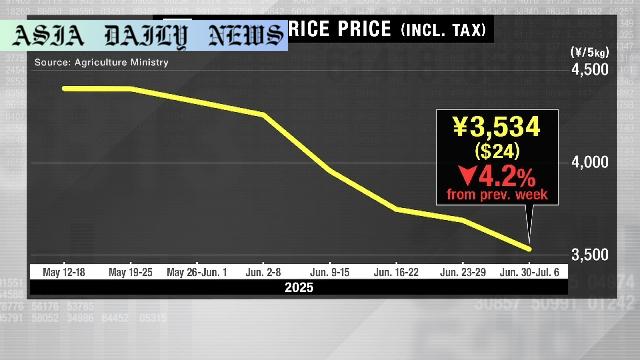Rice Prices: Retail rice prices in Japan drop for the seventh consecutive week due to an increase in affordable supplies from stockpiles.

Decline in Rice Prices Demonstrates Significant Trends
Retail rice prices in Japan have seen a notable decline for seven consecutive weeks, illustrating a remarkable trend in staple commodity markets. According to recent data released by Japan’s agriculture ministry, the average price of rice sold during the week ending on July 6 stood at 3,534 yen (approximately 24 USD) per 5 kilograms. This represents a significant drop of 4.25% from the prior week. The downward trajectory is attributed to the wider distribution of lower-cost rice from government-held stockpiles, which has effectively increased the availability of affordable options for consumers across the country.
The ministry’s data collection, encompassing insights from over 6,000 supermarkets, drug stores, and home improvement outlets nationwide, highlights this consistent shift in pricing. Among the country’s regions, Kyushu and Okinawa in the southwest emerged as the frontrunners for the lowest prices, with averages slightly exceeding 3,000 yen (less than 21 USD). Meanwhile, in Hokkaido in the north, the price descended further to nearly 3,200 yen or about 21 USD, marking a weekly decline of approximately 4 dollars.
Regional Disparities Highlight Economic Impacts
The broader perspective reveals noticeable price disparities across Japan’s regions. While most areas, including Tokai and Hokuriku, observed prices dipping below the threshold of 4,000 yen, certain regions have exhibited unique trends. Notably, the central Shinetsu region saw a slight rebound in prices, surpassing the 3,000-yen mark once again. Such regional fluctuations underscore the multifaceted nature of the commodity’s market dynamics, shaped by local demand-supply balances and transportation costs.
Beyond the immediate price declines, the trend signifies economic implications for both vendors and consumers. For the former, lower prices may compress profit margins in the short term, whereas households across the nation could experience a reduction in grocery expenditure. Such scenarios are vital indicators of shifting market forces and provide insights into the government’s strategic use of its stockpiles to stabilize essential goods in turbulent times.
Ongoing Monitoring and Future Potential
Given the trajectory of price movements, continuous monitoring by the agriculture ministry and related stakeholders will remain paramount. The prolonged trend of falling rice prices can deliver both opportunities and challenges to different sectors of the economy. Consumers will likely welcome the affordability, particularly during a period of global economic uncertainties and inflationary pressures.
However, policymakers must be cautious in ensuring sustainable practices, preventing over-reliance on governmental stockpile strategies that may deplete reserves. Future developments in this context can serve as a benchmark for global food-based economies, offering viable solutions to navigating disruptions in agricultural supply chains.
In conclusion, the persistent drop in rice prices in Japan carries far-reaching economic and social consequences, reflecting a critical intersection of governmental policies and market demands. The coming months will serve as a pivotal period to observe how these trends evolve and inform longer-term commodity strategies nationwide.
Commentary
The Significance of Declining Rice Prices
The steady decline in retail rice prices across Japan offers a pivotal opportunity to reflect on broader trends in agricultural economics and consumer markets. The reduced prices—fueled by increased availability from governmental stockpiles—underscore the importance of proactive policy interventions. This development has especially resonated with households across Japan, where rice serves as a foundational staple, influencing both dietary habits and financial planning. Observing this decline sheds light on the challenges and potential inherent in Japan’s agricultural management strategies.
Economic Implications and Regional Insights
Breaking down the prices by region provides fascinating insights into Japan’s economic microcosms. With Kyushu and Okinawa paving the way in terms of affordability, followed closely by Hokkaido, consumers in these regions might benefit from more constrained budgets or strategic governmental focus. Yet, the slight rebound in the Shinetsu region highlights the complexity inherent in pricing mechanisms: supply chains, local consumption patterns, and logistical hurdles all inevitably play a role.
For policymakers, these declining prices mirror their ongoing commitment to ensuring stable, equitable access to staple foods. However, caution must prevail: overly aggressive market interventions can risk depleting reserves or unsettling long-term market stability. Thus, striking a balance between accessibility and sustainability should remain a guiding principle.
Potential Global Implications
The trends observed in Japan also carry global resonance, as other nations grapple with volatile food prices stemming from supply chain disruptions and climate challenges. Policymakers worldwide can learn from Japan’s targeted use of reserves to stabilize key commodities while navigating the inherent trade-offs of such interventions. Ultimately, fostering resilience in agricultural ecosystems remains paramount to securing food security in an increasingly unpredictable world.
In summary, Japan’s current experience with falling rice prices offers valuable lessons to consumers, vendors, and policymakers alike, highlighting the profound interconnectedness of supply chains and market forces in shaping national economies.


